Topics
Category
Era
Maple Sugaring and the Ojibwe
Maggie Sengoge and Porky White drill into a tree in order to collect maple sap as part of the Heart of the Earth Survival School. Photograph by Randy Croce, 1984.
Ojibwe people have made maple sugar, a traditional dietary staple, for centuries. It is easily accessed in the woodlands of Minnesota and can be stored for months without spoiling. While the technology used in the process has changed over the years, Ojibwe people continue to harvest maple sugar in the present day.
Native people have produced maple sugar since time immemorial throughout the Great Lakes and New England. It is produced by boiling the sap of the sugar maple tree (acer saccharum), which grows throughout Minnesota. While the sap of other tree species, such as birch and other maple varieties, can be harvested, sugar maple sap contains the highest concentration of sugar. It takes about thirty-five gallons of sap to produce one gallon of maple syrup.
In Minnesota, the harvest of maple sugar usually occurs between mid-March and mid-April, when temperatures are above freezing during the day and below freezing at night. Sap is most plentiful at this time of year as it is the beginning of the trees’ annual growth cycle.
The harvesting process begins with the drilling of small holes about one-inch deep into maple trees. (Before the advent of drills, Ojibwe harvesters would simply gash the trees with an axe.) Next, spigots are pounded into the trees to divert the flow of their sap. Taps made of sumac were common, as sumac branches of two to three inches in diameter can be easily hollowed out. Since the late 1700s, Ojibwe people have also used metal taps.
In the next step of the harvesting process, the dripping sap is collected in a container placed at each tree. Historically, the Ojibwe used birch bark containers for this, as they were easily stacked. Finally, the sap is collected from each tree and boiled in a larger kettle made of cast iron or stainless steel. The process of making maple sugar was greatly aided when Ojibwe people began acquiring cast iron kettles from French traders in the seventeenth century. Prior to this, the Ojibwe boiled thousands of gallons of maple sap in kettles made of birch bark or copper.
Once they had collected the sap in kettles, Ojibwe people boiled it down into granulated sugar, which was used as the primary seasoning in food. Writing in 1855, German ethnographer Johann Kohl noted: “They are fond of mixing their meat with sweets, and even sprinkle sugar or maple syrup over fish boiled in water.” If kept dry, granulated sugar will not spoil for months, providing Ojibwe people with a food source throughout the year.
Before the reservation era (ca. 1871–1928), the opening of sugar camps every spring played an important role in the social life of Ojibwe communities. During the winter, Ojibwe people scattered into family groups of around a dozen people. The opening of sugar camp in the early spring marked the beginning of Ojibwe communities coming back together into larger groups for food production, ceremonies, and social events.
Historically, women performed most of the labor associated with maple sugar production, with men working in supporting roles such as cutting firewood and supplying food by hunting and fishing. This began to change during the twentieth century as entire families worked in sugar camps. Mille Lacs elder Larry “Amik” Smallwood described his family’s sugar camp during his childhood in the 1950s: “Families would help each other and everybody would have a role. There was the wood cutters, the gatherers of water, the boilers, the food makers. It was really a lot of fun long ago.”
In the twenty-first century, Ojibwe people continue to harvest maple sugar, which remains an important traditional food source. Ojibwe families operate camps on reservations throughout Minnesota and may also gather maple sugar off-reservation on county, state, and federal lands in east-central Minnesota—a right derived from the 1837 Treaty of St. Peters and subsequent interpretations, including a 1999 Supreme Court case.
Maple sugar is a vital resource in preserving Ojibwe culture and sovereignty. Mille Lacs elder Larry “Amik” Smallwood noted: “We treat that maple syrup with respect. The same as we would wild rice. If you burn some, if you spill it, if you waste any unintentionally, you got to do a little tobacco ceremony for that because it’s a gift from the Creator.”
Bibliography
Densmore, Frances. Strength of the Earth: The Classic Guide to Ojibwe Uses of Native Plants. 1928. Reprint, St. Paul: Minnesota Historical Society Press, 2005.
Kellar, Robert H. “America’s Native Sweet: Chippewa Treaties and the Right to Harvest Maple Sugar.” American Indian Quarterly 13, no. 2 (1989): 117–35.
Kohl, Johann Georg. Kitchi-Gami: Life among the Lake Superior Ojibway. Translated By Lascelles Wraxall. St. Paul: Minnesota Historical Society Press, 1985.
Smallwood, Larry “Amik.” “Ojibwe Stories: Gaganoonididaa: Maple Syrup.” KUMD 101.3-FM, Duluth, Minnesota, April 20, 2015.
http://kumd.org/post/420-ojibwe-stories-gaganoonididaa-maple-syrup
Related Resources
Secondary
“Iskigamizigan (Sugarbush): A Sequel to ‘Growing Up Ojibwe.’” Mazina’igan supplement. Great Lakes Indian Fish and Wildlife Commission, 2006.
https://www.glifwc.org/publications/pdf/Iskigamizigan_Supplement.pdf
McClurken, James M. Fish in the Lakes, Wild Rice, and Game in Abundance: Testimony on Behalf of Mille Lacs Ojibwe Hunting and Fishing Rights. East Lansing, MI: Michigan State University Press, 2000.
Related Video
Sugarbush
Ojibwe people have made maple sugar for centuries and they continue to make it today. Watch how it's done in this video, shot in 2011. It takes about thirty-five gallons of sap to produce just one gallon of maple syrup. From there, the syrup can be boiled down further to get about seven pounds of sugar from one gallon of maple syrup.
More Information
Articles
Related Images

Maggie Sengoge and Porky White tapping a tree for maple sap
Maggie Sengoge and Porky White drill into a tree in order to collect maple sap as part of the Heart of the Earth Survival School. Photograph by Randy Croce, 1984.
Holding Location
More Information
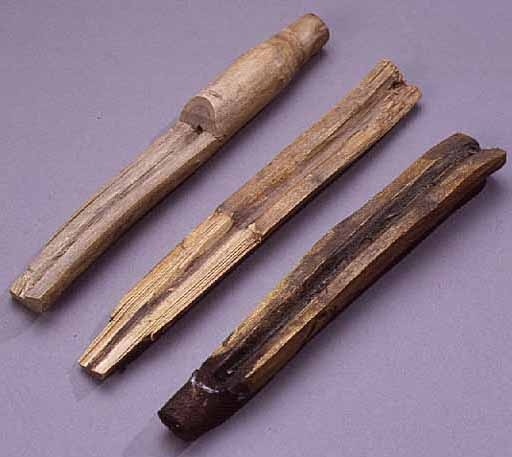
Wooden sap spigots
Three wooden sap spigots made no later than 1961. Forms part of the Jeannette O. and Harry D. Ayer Ojibwe Collection.
All rights reserved
Holding Location
Articles
More Information

Metal sap spigot
Metal spigot used to direct maple sap from a tree. Used by the Red Lake Band of Chippewa, 1920–1925.
All rights reserved
Holding Location
Articles
More Information
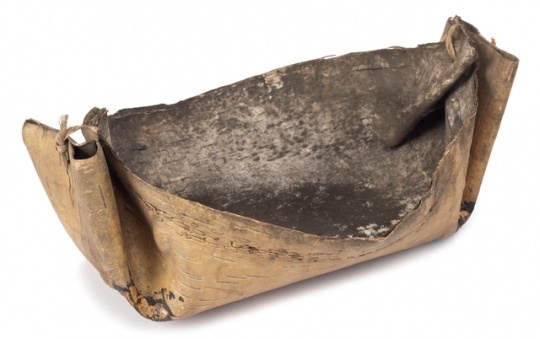
Birchbark sap bucket
Sap bucket formed from a single piece of birchbark folded together at the ends and sewn with basswood strips to form an oval dish. It was used for gathering sugar maple sap to be refined into syrup or sugar. From the Bois Forte Reservation, Minnesota, circa 1880.
All rights reserved
Holding Location
Articles
More Information

Maple sugaring paddle
Paddle used for working maple sugar by the Big Bear family (White Earth Band of Ojibwe) ca. 1800s.
All rights reserved
Holding Location
Articles
More Information
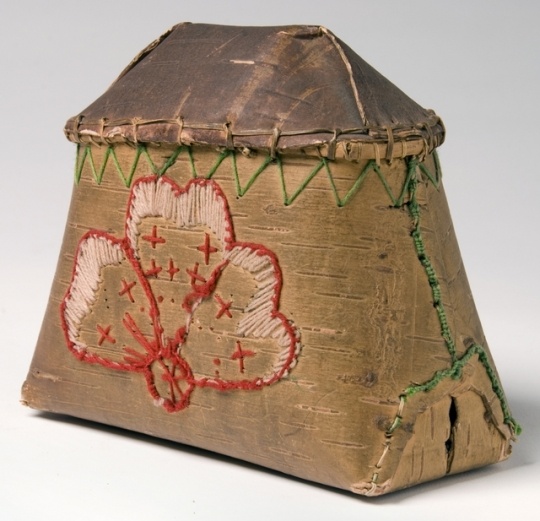
Miniature makak with maple sugar
Miniature birchbark makak (storage container) filled with maple sugar, ca. late 1800s–early 1900s. Collected by Darwin S. Hall at the White Earth Reservation of Ojibwe.
All rights reserved
Holding Location
Articles
More Information
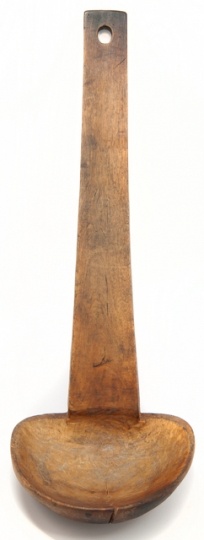
Maple sugaring skimming ladle
Ladle used as a maple sugaring skimmer by the Grand Portage Band of Lake Superior Chippewa, 1900–1930.
All rights reserved
Holding Location
Articles
More Information
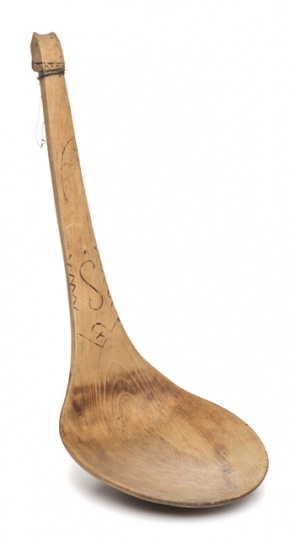
Sugaring spoon
Spoon with burnt decoration on handle used for maple sugaring, ca. 1900–1950.
All rights reserved
Holding Location
Articles
More Information
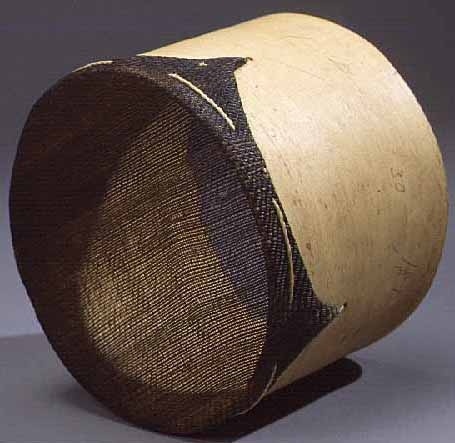
Sap strainer
Sieve used to strain out impurities from maple syrup after it had been boiled down. Used no later than 1959. Forms part of the Jeannette O. and Harry D. Dyer Ojibwe Collection.
All rights reserved
Holding Location
Articles
More Information
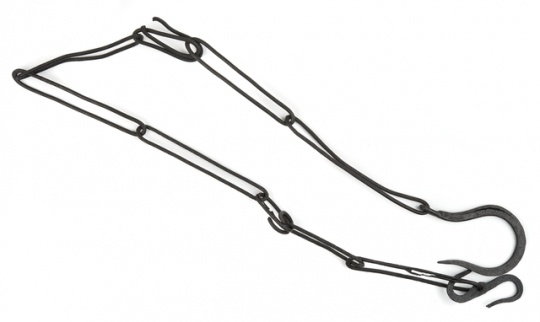
Firepit chain
Wrought iron chain used by members of the Grand Portage Chippewa (ca. 1850–1920) to suspend kettles over a fire during the processing of maple sap.
All rights reserved
Holding Location
Articles
More Information
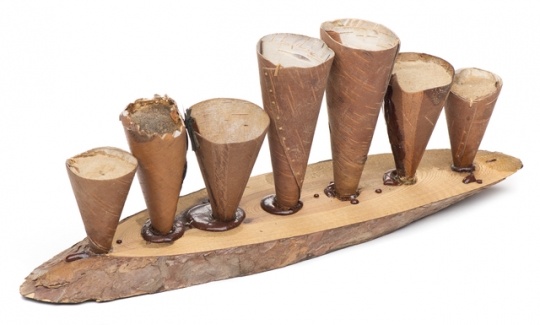
Birchbark cones with maple syrup
Set of seven birchbark cones mounted onto a wooden base. Four of the cones are filled with hardened maple syrup. Collected by Frances Densmore from the Grand Portage Reservation of Chippewa no later than 1930.
All rights reserved
Holding Location
Articles
More Information
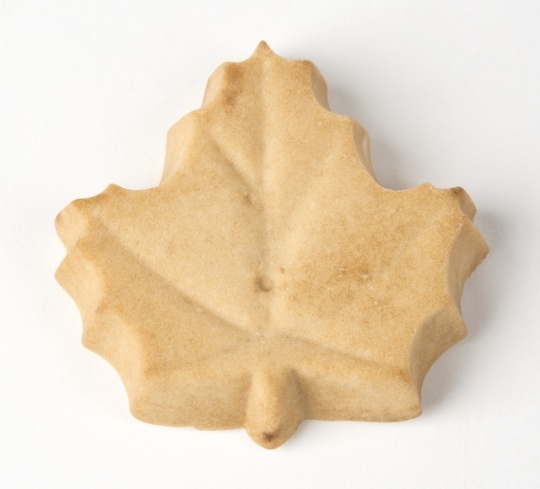
Maple sugar candy
Maple sugar candy molded into the shape of a maple leaf. From the Mille Lacs Band of Ojibwe, 1960–1985.
All rights reserved
Holding Location
Articles
More Information
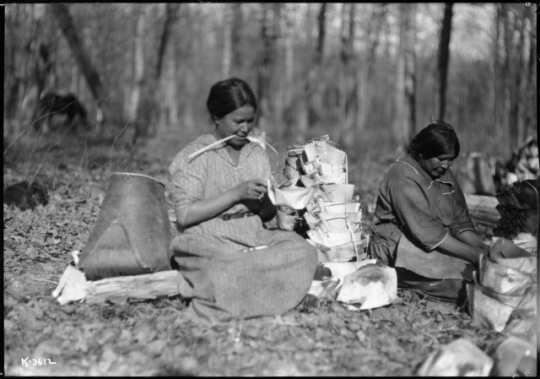
Mary Bigwind and Maggie Skinaway making birch bark containers for maple sap
Photograph by Kenneth Melvin Wright, ca. 1930.
Holding Location
Articles
More Information
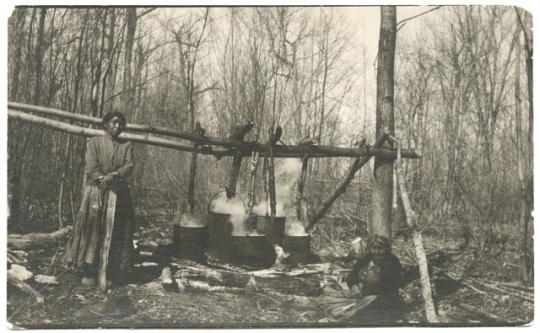
Ojibwe women making maple sugar at Cass Lake
Ojibwe women making maple sugar at Cass Lake on the Leech Lake Reservation of Ojibwe, ca. 1920.
Holding Location
Articles
More Information

Um-be-quay (Mrs. John Mink) making maple sugar
Um-be-quay (Mrs. John Mink) making maple sugar on the Mille Lacs Reservation of Ojibwe, ca. 1925.
Holding Location
Articles
More Information
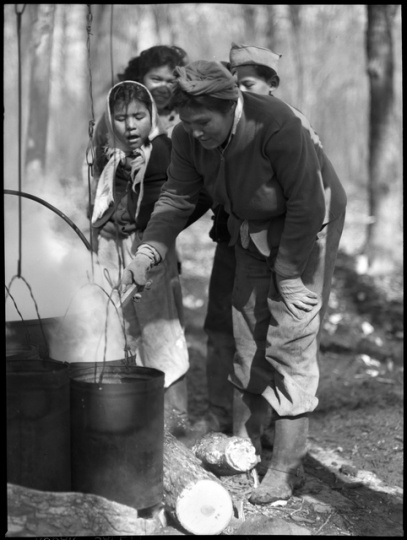
Making maple sugar on the Mille Lacs Reservation of Ojibwe
Making maple sugar on the Mille Lacs Reservation of Ojibwe, April 19, 1946. Photograph by Monroe P. Killy.
Holding Location
Articles
More Information
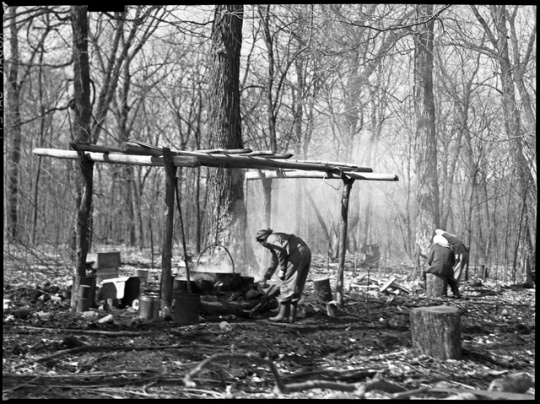
Making maple sugar on the Mille Lacs Reservation of Ojibwe
Making maple sugar on the Mille Lacs Reservation of Ojibwe, April 19, 1946. Photograph by Monroe P. Killy.
Holding Location
Articles
More Information
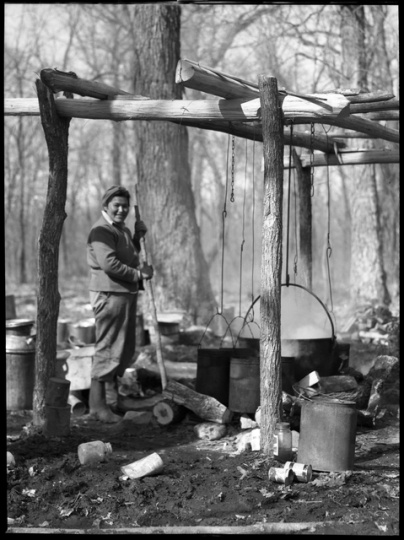
Making maple sugar on the Mille Lacs Reservation of Ojibwe
Making maple sugar on the Mille Lacs Reservation of Ojibwe, April 19, 1946. Photograph by Monroe P. Killy.
Holding Location
Articles
More Information
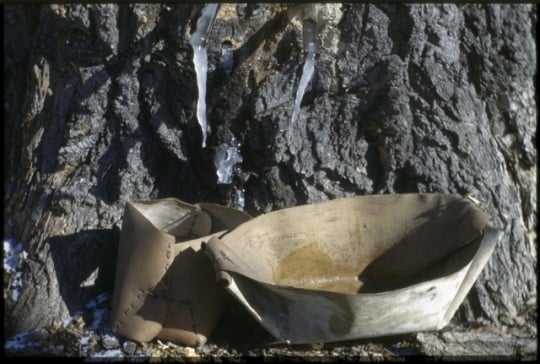
Maple sap icicle
Icicle made out of sap on a tree being tapped for sugar. Photograph by Moroe P. Killy, April 19, 1947.
Holding Location
Articles
More Information

Maple trees in maple sugar camp
Maple trees in a maple sugar camp. Photograph by Randy Croce, 1984.
Holding Location
Articles
More Information
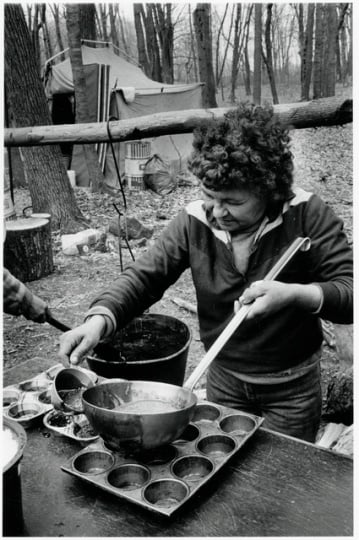
Maddy Moose making maple sugar at the Heart of the Earth Survival School
Maddy Moose making maple sugar at the Heart of the Earth Survival School (of Minneapolis) sugar bush camp, Maple Plain. Photograph by Randy Croce, 1984.
Holding Location
Articles
More Information
Related Articles
Turning Point
In the seventeenth century, French traders introduce cast iron kettles are introduced to the Ojibwe. Ojibwe people begin to use them to boil tree sap during their maple sugar harvests.
Chronology
1600s
1837
1842
1854
1863
1930s
1999
2010s
Bibliography
Densmore, Frances. Strength of the Earth: The Classic Guide to Ojibwe Uses of Native Plants. 1928. Reprint, St. Paul: Minnesota Historical Society Press, 2005.
Kellar, Robert H. “America’s Native Sweet: Chippewa Treaties and the Right to Harvest Maple Sugar.” American Indian Quarterly 13, no. 2 (1989): 117–35.
Kohl, Johann Georg. Kitchi-Gami: Life among the Lake Superior Ojibway. Translated By Lascelles Wraxall. St. Paul: Minnesota Historical Society Press, 1985.
Smallwood, Larry “Amik.” “Ojibwe Stories: Gaganoonididaa: Maple Syrup.” KUMD 101.3-FM, Duluth, Minnesota, April 20, 2015.
http://kumd.org/post/420-ojibwe-stories-gaganoonididaa-maple-syrup
Related Resources
Secondary
“Iskigamizigan (Sugarbush): A Sequel to ‘Growing Up Ojibwe.’” Mazina’igan supplement. Great Lakes Indian Fish and Wildlife Commission, 2006.
https://www.glifwc.org/publications/pdf/Iskigamizigan_Supplement.pdf
McClurken, James M. Fish in the Lakes, Wild Rice, and Game in Abundance: Testimony on Behalf of Mille Lacs Ojibwe Hunting and Fishing Rights. East Lansing, MI: Michigan State University Press, 2000.























